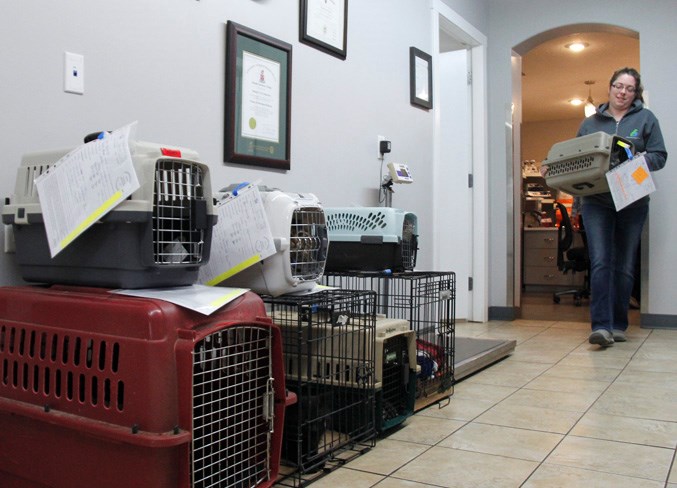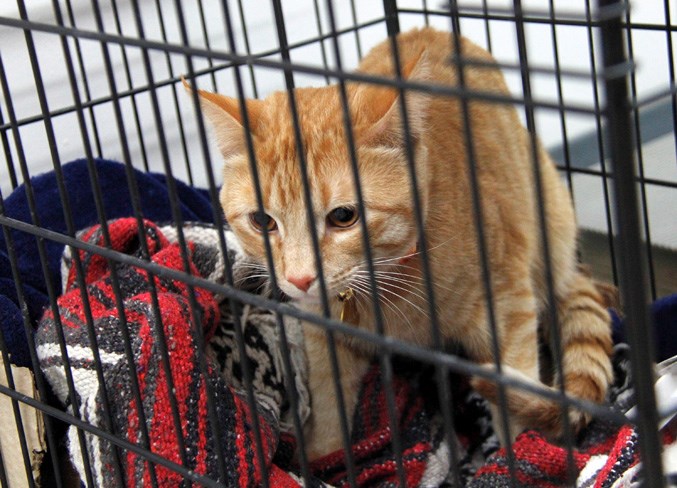The community has pulled together to solve a common problem throughout the MD: stray cats.
The MD Rural Cat Spay and Neuter Program held its first test run on Thursday, May 17, with the help of the volunteers and the Bonnyville Veterinary Clinic.
This was the pilot of a program initiated by Silke Skinner and funded by the MD, which aims to tackle the growing stray and barn cat population across the municipality.
All of the available spots for both female and male cats were filled, with a wait list that continues to grow.
 Volunteer Lisa Ferguson carries a kennel past a row of cats waiting to be spayed or neutered.
Volunteer Lisa Ferguson carries a kennel past a row of cats waiting to be spayed or neutered.
“I kept getting phone calls until the night before the clinic, from people wanting to have a spot for a cat too. I already have a waiting list for 47 females and 13 males; we have another clinic pretty much full,” Skinner emphasized.
This, she said, is a clear indication that there is a problem in their area.
“The need is huge, obviously with the amount I have on the waiting list. I hope that council will see that.”
Bonnyville Veterinary Clinic owner and veterinarian Greg Benoit agreed that there was a strong need for the program, and as soon as they caught wind it was going ahead, they knew they had to be a part of it.
“We figured, as a clinic, we would jump in and help out all that we could,” Benoit expressed.
Benoit had done a rough estimate of the number of stray kittens they were preventing through the clinic. He figures if one female has five kittens for every litter, and has three litters throughout her lifetime, which was a small number compared to some cases, they would avert at least 150 kittens.
“I think if you start looking at those numbers, and thinking that you could do this a handful of times, how could you not at least make some of a dent in it? How much or how many times we would have to do this to get the stray population down, that’s an unknown, but I think we can at least move the needle on it,” he said.
Leanna Stencell, a Fort Kent resident, brought her cat into the clinic. After three litters of kittens, she was relieved to see the program come to the MD.
She said, “I think it’s a great idea, because you have people drop off barn cats and stray cats that otherwise wouldn’t get this opportunity because a lot of farms in this area don’t spay or neuter their pets.”
Stencell has another female cat at home, and would love the opportunity to drop her off if they hosted another clinic.
Like many of those who attended or volunteered for the clinic, she agreed the program would make a difference.
“I think this will make a big impact in the farm and rural communities to control the cat population because there are a lot wandering out there,” Stencell stated.
Clinic volunteer and Cold Lake resident Lisa Ferguson agreed, “The more cats that are fixed and are out free roaming is going to help reduce the populations of feral and free roaming cats in the community. It’s definitely a problem that we have.”
Ferguson is a volunteer with the Alberta Spay and Neuter Task Force.
Through the organization, she has witnessed first-hand the impact of a spay and neuter program.
“We’re definitely seeing reduced numbers with other programs. If we continue with this, it will help drop the numbers.”
Because this clinic was so successful, Silke is already starting the process of planning another one.
As soon as she has all of her data collected on the outcome of the pilot, she will be heading to council to present the results.
“As soon as we’re done with this clinic, I will put together a report and I will ask for a spot in an upcoming council meeting. I will show my report and ask for more money.”
Silke is hoping that they will be able to host another one in the near future, especially after receiving such positive feedback from residents.
The program was specifically directed to feral, barn, and stray cats in the MD. Residents were required to show proof of residence, but Silke was relying on the honour system when it came to whether or not the cat was free roaming.
“Household cats were excluded from the program. It’s an honour system. We asked for a land location, and we repeatedly let residents know it was for ferals, strays, and barn cats,” Silke detailed. “We want people to be honest, because we’re trying to get the population down in the MD, and a house cat isn’t wandering around the MD producing more little ones.”
In some cases, residents were hoping to bring in more than one cat from their property, but unfortunately due to limited time and funding, they were only able to take in a set number.
“Otherwise, we could take all of the cats that they have.”



